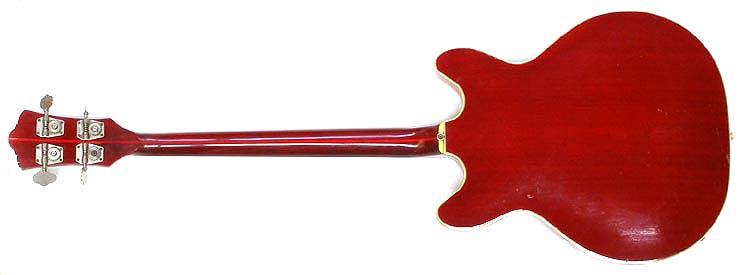

| The Guild Starfire is a classic mid-’60s vintage bass that came along at a time when manufacturers were just beginning to move away from the “guitar body with a bass neck” approach to bass guitar building. It still has most of the characteristics of Guild’s Starfire guitar series, but with a less fragile feel than many of the other short-scale hollowbodies of the day. The Starfire Bass also represented a significant sonic step forward, due to its full-range humbucking pickup. It played an interesting and pivotal role in the development of some of the first high-end basses in the late ’60s and early ’70s. Introduced in 1965 as a companion to the Starfire guitar, which debuted in 1963, the Starfire Bass is quite similar to the single-pickup Gibson EB-2, first manufactured in 1959. (The two-pickup Starfire II came along in 1967.) This Starfire has semi-flatwound strings fitted, which give a great balance between an 'acoustic' bass tone and the more trebly sound of round-wounds on a solid-body. The Starfire’s neck is chunkier and a bit stiffer than a Gibson EB bass, but it’s still really easy to get around on compared to a Fender-style neck. The acoustic tone is noticeably louder than a Gibson’s, and it also has a more even amplified tone from string to string, with fewer dead spots. For those unafraid of the high register, the Starfire has one additional fret so you can hit the high E at the end of your solo! The crown jewel of this instrument is the large, Swedish-made Hagstrom pickup. It has a sweet, rich sound, with quite a bit more highs and a lot more output than the Gibson’s pickup (as well as most other pickups from that time). Two of the most innovative rock bassists of the psychedelic era, the Grateful Dead’s Phil Lesh and Jack Casady of the Jefferson Airplane and Hot Tuna, were early users of the Starfire basses. Part of their quest for improved sonics was the extensive modification of existing designs; the Starfire’s Hagstrom pickup became a starting point for experimentation with active preamps and tone circuitry, led by Ron Wickersham, who soon afterward founded Alembic and began the era of high-end bass building. Casady’s heavily modified Starfire had a beefy, resonant, and wonderfully dirty tone, which can be heard on the Airplane’s live album Bless Its Pointed Little Head [RCA]. When Guild stopped using the Hagstrom pickup in 1972, the Starfire’s popularity began to fall off. The bass was discontinued in 1977. Subsequent reissues have not included the Hagstrom-style pickup and have yet to capture the unique sound of the original Starfire I, which is still a cult favorite. Nashville session player and ex-Giant bassist Mike Brignardello uses his as an alternative instrument choice when he needs a rootsy, nasty tone. Flatwounds sound great on it, and it lends itself well to pickstyle playing, especially with a bit of palm-muting. While the Starfire I really has only one sound, it’s a very good sound—one that certainly played an important role in the evolution of modern bass tone. This example is a true gem, displaying virtually no fret wear, and only the lightest of any play wear at all. The back, as well as the front, of the body is triple-bound, and the mother-of-pearl headstock inlays are as brilliant now as they were back in 1967. The bass plays and sounds superb - quite different to anything else! And just look at that case! Not the strongest in the world, but has to be amongst the coolest! (see the more pictures link below). The original keys for the case are still clipped to the inside! Serial number of BA-947 places this bang in the middle of 1967. No drugs or sex included, but you can definitely Rock & Roll! sold to Martin |